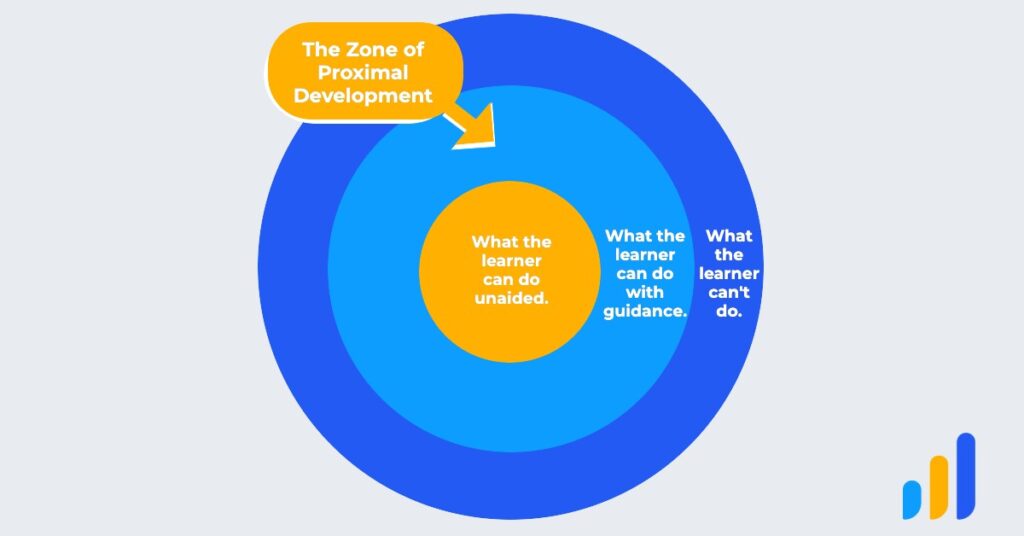
How to Design Courses that Keep Learners in the Zone
Courses lose learners when they are either too hard or too easy. How can you stay in the sweet spot?
One of the greatest challenges for online instructors is to keep their learners motivated after their initial burst of excitement. Many learners sign up for a course excited about what they will be learning, but once they get a week or two in, they become fatigued and drop out. To combat learner burnout, many instructors focus on more interactive material, building community support, and finding ways to reengage learners who have stopped logging in to their account.
All of these strategies are important and effective, as we have written before. But there’s another aspect to building learner engagement, and that has to do with finding a learner’s sweet spot—the zone of proximal development (ZPD), according to developmental psychology.
The idea behind the ZPD is that there are three broad areas that describe a learner’s abilities: What the learner can do unaided, what a learner can do with assistance (the ZPD), and what a learner cannot do.

If you only present a learner with the material they can already do, they will become bored and disengaged. On the other hand, if you present material that a learner cannot do, the will become frustrated and burn out. As an educator, your goal is to stay within the ZPD. By quite literally keeping learners in the “zone,” you can help them grow their abilities—and in turn, their confidence and motivation.
Here’s how to apply this to your course.
1. Attract an audience with the right skill level.
The first task is to make sure your learners are signing up for the right course. If you’re getting a lot of beginners in what should be an advanced course, that’s a sign you need to create easier material—and market it as such. Similarly, if all you offer is beginner courses, you may need to expand your offerings to include intermediate and advanced material.
No matter what you’re teaching, give learners a clear idea of the skill level they should have when they enter a course. This will help you attract the right learner, without accidentally recruiting the wrong one.
2. Identify points in your course that are going to be more challenging.
Next up, take a hard look at your course progression. In nearly every course I’ve taken, there’s always been a lesson, a week, or sometimes even a full course that everyone knows is the “hardest.” You may know this from your own experience, or you may have observed it from the way learners respond to your content.
These moments are usually the hardest because the involve a larger leap in knowledge and skill than at other points in the course. Sometimes that’s unavoidable, but sometimes it’s because the instructor hasn’t taken the time to cover foundational principles that may make that leap easier. Look for ways to better prepare your learners before the known stumbling blocks so that you don’t lose them along the way.
3. Create dynamic course progression.
Even if you successfully market your courses as being for various levels, individual learners will have different experiences handling your course subjects. Some may find a lesson easy, while others may struggle with it for much longer.
You can help tailor content to each learner’s needs by using dynamic course progression. This lets you use placement quizzes to determine what material a learner needs to cover next. The Adaptive Learning plugin from WooNinjas enables this by letting educators create nonlinear courses that adapt to learner needs. It’s a great way to keep content focused on the learner.
4. Break your content into shorter pieces to keep learners from burning out.
No matter how well a learner is doing in a course, their energy will flag if a lesson is too long. A learner who might have been flying along without any problems at the beginning of a lesson will become tired if the material goes on for too long without a break. To maintain learner interest, it’s essential to offer content in digestible pieces.
Look at the length of your lessons and see if you can break them into shorter segments. Videos shouldn’t be longer than twenty minutes at the maximum, and you may find you get better engagement with shorter segments of five to seven minutes. Offer lessons in five to ten minute chunks, and include short review quizzes at the end.
When learners see they scored well, it reinforces their knowledge and encourages to keep going. And if they’re tired or need to move on to another task, the breaking point will help them feel as though they’ve accomplished something, instead of making them feel as though they’ve left a task unfinished.
5. Reward achievements with badges and points.
Finally, once a learner has absorbed the material well enough to be able to handle it without assistance, acknowledge it! Use points to show accumulated experience so that they can feel how far they’ve come, and use badges to mark the milestones they’ve achieve along the way. It may seem like a trivial detail, but for learners who have been working hard at your course for a long time, the reminder of how far they’ve come can be a meaningful encouragement to help them keep going.
Your course design has a direct impact on learner motivation.
Learner motivation will ebb and flow over time, but your course design can keep them engaged after the first wave of enthusiasm subsides. As an educator, your goal is to help move abilities and knowledge from the “things the learner cannot do” column to the “things the learner can do unaided column.” You are there to provide assistance for everything in between.

LearnDash Collaborator
@LearnDashLMS






